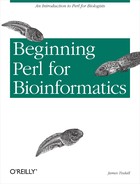Perl is a popular programming language that's extensively used in areas such as bioinformatics and web programming. Perl has become popular with biologists because it's so well-suited to several bioinformatics tasks.
Perl is also an application, just like any other application you might install on your computer. It is available (at no cost) and runs on all the operating systems found in the average biology lab (Unix and Linux, Macintosh, Windows, VMS, and more).[1] The Perl application on your computer takes a Perl language program (such as one of the programs you will write in this book), translates it into instructions the computer can understand, and runs (or "executes") it.
So, the word Perl refers both to the language in which you will write programs and to the application on your computer that runs those programs. You can always tell from context which meaning is being used.
Every computer language such as Perl needs to have a translator application (called an interpreter or compiler) that can turn programs into instructions the computer can actually run. So the Perl application is often referred to as the Perl interpreter, and it includes a Perl compiler as well. You will often see Perl programs referred to as Perl scripts or Perl code. The terms program, application, script, and executable are somewhat interchangeable. I refer to them as "programs" in this book.
A nice thing about Perl is that you can learn to write programs fairly quickly; in essence, Perl has a low learning curve. This means you can get started easily, without having to master a large body of information before writing useful programs.
Perl provides different styles of writing programs. Since these are beyond the scope of this book, I won't go into details, except to mention the popular style called imperative programming that you'll learn in this book. The equally popular style called object-oriented programming is also well-supported in Perl. Other styles of programming include functional programming and logic programming.
Although you can get started quickly, learning all of Perl will certainly take awhile, if that's your goal. Most people learn the basics, as presented in this book, and then learn additional topics as needed.
Let's get a few elementary definitions out of the way:
- What is a computer program?
It's a set of instructions written in a particular programming language that can be read by the computer. A program can be as simple as the following Perl language program to print some DNA sequence data onto the computer screen:
print 'ACCTGGTAACCCGGAGATTCCAGCT';
The Perl language programs are written and saved in files, which are ways of saving any kind of data (not only programs) on a computer. Files are organized hierarchically in groups called folders on Macintosh or Windows systems or directories in Unix or Linux systems. The terms folder and directory will be used interchangeably.
- What is a programming language?
It's a carefully defined set of rules for how to write computer programs. By learning the rules of the language, you can write programs that will run on your computer. Programming languages are similar to our own natural languages, such as English, but are more strictly defined and specific to certain computer systems. With a little bit of training, it's not difficult to read or write computer programs. In this book you'll write in Perl; there are many other programming languages.
A program that a programmer writes is also called source code, or just source or code. The source code has to be turned into machine language, a special language the computer can run. It's hard to write or read a machine language program because it's all binary numbers; it's often called a binary executable. You use the Perl interpreter (or compiler) to turn a Perl program into a running program, as you'll see later in this chapter.
- What is a computer?
Well, ...
Okay, silly question. It's that machine you buy in computer stores. But actually, it's important to have a clear idea of what kind of machine a computer is. Essentially, a computer is a machine that can run many different programs. This is the fundamental flexibility and adaptability that makes the computer such a useful and general-purpose tool. It's programmable; you will learn how to program it using the Perl programming language.
[1] An operating system manages the running of programs and other basic services that a computer provides, such as how files are stored.
